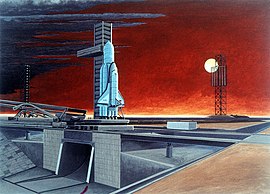Buran program

Illustration of Buran at launch pad
|
|
| Function | Crewed orbital launch and reentry |
|---|---|
| Manufacturer | RKK Energia |
| Country of origin | Soviet Union, later Russian Federation |
| Size | |
| Mass | 42,000 kg (93,000 lb) |
| Capacity | |
| Payload to LEO | 30,000 kg (66,000 lb) |
| Launch history | |
| Status | Decommissioned; programme halted in 1993; 1K1 destroyed in a 2002 hangar collapse, 1K2 in storage in Baikonur; 2K1 at Zukhovsky Airport; 2 other orbiters barely started when programme was cancelled. Test articles in various exhibitions. |
| Launch sites | Baikonur Cosmodrome |
| Total launches | 1 (1K1) |
| Successes | 1 |
| Failures | 0 |
| First flight | 15 November 1988 (1K1) |
| Last flight | 15 November 1988 (1K1) |
| Notable payloads | N/A |
| stage - Energia rocket | |
| Engines | 1 RD-170 (4 nozzles) |
| Thrust | 29,000 kN (6,500,000 lbf) sea level 32,000 kN (7,200,000 lbf) vacuum |
| Specific impulse | 309 s at sea level 338 s in vacuum |
| Fuel | RP-1/LOX |
| Core stage | |
| Engines | 4 RD-0120 |
| Thrust | 5,800 kN (1,300,000 lbf) sea level 7,500 kN (1,700,000 lbf) vacuum |
| Specific impulse | 359 s at sea level 454 s in vacuum |
| Burn time | 480–500 s |
| Fuel | LH2/LOX |
The Buran (Russian: Бура́н, IPA: [bʊˈran], "Snowstorm" or "Blizzard") programme, also known as the VKK Space Orbiter (Russian: Воздушно Космический Корабль, "Air Space Ship") programme, was a Soviet and later Russian reusable spacecraft project that began in 1974 at the Central Aerohydrodynamic Institute and was formally suspended in 1993. In addition to being the designation for the whole Soviet/Russian reusable spacecraft project, Buran was also the name given to Orbiter K1, which completed one unmanned spaceflight in 1988 and was the only Soviet reusable spacecraft to be launched into space. The Buran-class space shuttle orbiters used the expendable Energia rocket as a launch vehicle. They are generally treated as a Soviet equivalent of the United States' Space Shuttle but in the Buran project, only the airplane-shaped orbiter itself was theoretically reusable, and while Orbiter K1 was recovered successfully after its first orbital flight in 1988, it was never reused.
The Buran programme was started by the Soviet Union as a response to the United States Space Shuttle program. The project was the largest and the most expensive in the history of Soviet space exploration. Development work included sending BOR-5 test vehicles on multiple sub-orbital test flights, and atmospheric flights of the OK-GLI aerodynamic prototype. Buran completed one unmanned orbital spaceflight in 1988 before its cancellation in 1993.Orbiter K1, which flew the test flight in 1988 was crushed in a hangar collapse on 12 May 2002 in Kazakhstan. The OK-GLI resides in Technikmuseum Speyer. Although Soviet/Russian Buran spacecraft was similar in appearance to NASA's Space Shuttle, and could similarly operate as a re-entry spaceplane, its internal and functional design was distinct. For example, the main engines during launch were on the Energia rocket and were not taken into orbit by the spacecraft. Smaller rocket engines on the craft's body provided propulsion in orbit and de-orbital burns.
...
Wikipedia
